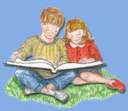 1. Bibliography: Yang, Gene Luen. 2007. American Born Chinese. New York: First Second. ISBN#: 978-1-59643-152-2.
1. Bibliography: Yang, Gene Luen. 2007. American Born Chinese. New York: First Second. ISBN#: 978-1-59643-152-2.- Booklist: With vibrant colors and visual panache, indie writer-illustrator Yang (Rosary Comic Book) focuses on three characters in tales that touch on facets of Chinese American life. Jin is a boy faced with the casual racism of fellow students and the pressure of his crush on a Caucasian girl; the Monkey King, a character from Chinese folklore, has attained great power but feels he is being held back because of what the gods perceive as his lowly status; and Danny, a popular high-school student, suffers through an annual visit from his cousin Chin-Kee, a walking, talking compendium of exaggerated Chinese stereotypes. Each of the characters is flawed but familiar, and, in a clever postmodern twist, all share a deep, unforeseen connection. Yang helps the humor shine by using his art to exaggerate or contradict the words, creating a synthesis that marks an accomplished graphic storyteller. The stories have a simple, engaging sweep to them, but their weighty subjects--shame, racism, and friendship--receive thoughtful, powerful examination.
- Library Media Connection: In this graphic novel, three humorous and seemingly unrelated stories keep the reader's attention until they come together at the end. The first story concerns a Chinese-American boy trying to fit in. The second is a retelling of the Chinese fable of the monkey king. Those familiar with the anime/manga Saiyuki will immediately recognize the characters of the monk, water sprite, and boar in the Journey to the West. The third story involves a Chinese cousin who visits an American boy each year. The depiction of the cousin is so painfully stereotypical that you feel guilty laughing. In each story, the central character is unsatisfied with who he is and goes to great lengths to be someone else-with humorous results. The reader might be puzzled as to how the three stories are connected until the conclusion. It's a nice combination of a fable and contemporary stories to convey the wonderful lesson of accepting one's culture and identity with pride. A quick read, this title has engaging art, and at times, funny dialogue. There are some mild sexual references. One of my students, an active graphic novel reader, pronounced it, "Really funny with good characters."
5. Connections:
- Develop a cultural awareness unit. Students may share experiences, traditions, and stories about their own cultures. If possible, invite parents and/or grandparents to visit and share cultural stories and experiences with the class.
- Share literature about children from other cultures living in America and discuss their thoughts.
















